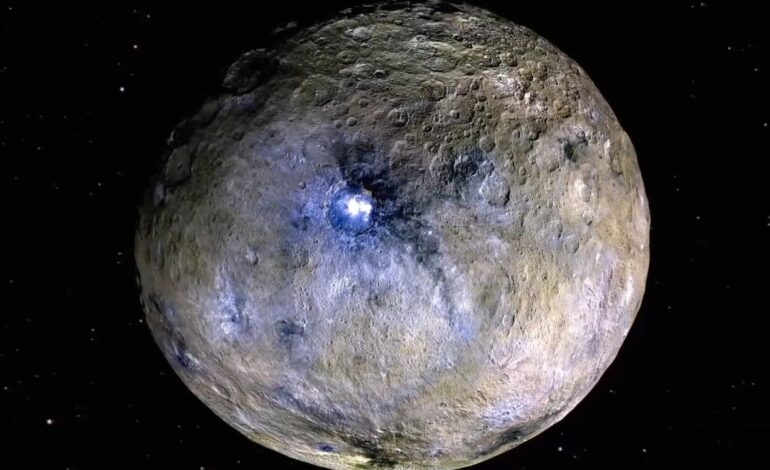New Study Reveals Ceres May Have Once Supported Life

Research suggests that the dwarf planet Ceres, located in the asteroid belt between Mars and Jupiter, may have once provided conditions suitable for simple microbial life. A study published on August 20, 2023, in the journal Science Advances indicates that Ceres had essential ingredients for life billions of years ago, challenging its long-standing image as a frozen, lifeless relic of the early solar system.
Ceres measures approximately 600 miles (about 960 kilometers) in diameter, making it the largest object in the asteroid belt. Unlike other icy moons, such as Europa and Enceladus, which receive warmth from the gravitational pull of nearby giant planets, Ceres lacks an external energy source. This absence raised questions about its ability to sustain life.
The new study utilized data from NASA’s Dawn spacecraft to explore Ceres’ past. Researchers have identified bright, reflective patches on its surface as salt deposits formed from briny liquids that once ascended from the interior. Additionally, organic molecules discovered in the soil suggest that essential components for life were present.
To address the missing piece—the energy required to support life—scientists employed computer models to simulate the interior of Ceres over billions of years. They found that between 2.5 and 4 billion years ago, radioactive decay within Ceres’ rocky core could have generated sufficient heat to drive hydrothermal activity. This process could have facilitated the circulation of water within the planet, reacting with heated rock and producing minerals and gases.
Samuel Courville, a researcher at Arizona State University and the lead author of the study, explained, “On Earth, when hot water from deep underground mixes with the ocean, the result is often a buffet for microbes—a feast of chemical energy.” This analogy highlights the potential for Ceres to have hosted similar conditions conducive to microbial life.
While it remains uncertain whether life ever took hold on Ceres, the findings significantly broaden the scope of environments considered potentially habitable. Researchers emphasize that Ceres serves as a straightforward case study for understanding the evolutionary paths of small, icy bodies in the solar system.
The implications extend beyond Ceres, as the study also points to other icy worlds roughly the size of the dwarf planet, including some moons of Uranus and Saturn. These bodies may have experienced similar evolutionary histories and could have supported temporary oceans capable of sustaining life before transitioning to their current frozen states.
As scientists continue to explore the mysteries of Ceres and its potential past habitability, this research not only reshapes our understanding of Ceres but also offers insights into the conditions that may have existed on other celestial bodies in the solar system.






